Tours

Rome Tourist Card
Rome Tourist Card
Snap up the Rome Tourist Card and you'll get everything you need to explore Rome's top highlights including Colosseum, Palatine Hill, Roman Forum and Hop on/off bus. You can even choose the order you see things in.

Colosseum, Roman Forum & Palatine Hill: Priority Entrance
Colosseum, Roman Forum & Palatine Hill: Priority Entrance
Skip the long lines at the Colosseum with this priority-entrance ticket. This ticket will let you bypass the crowds. And after exploring the Colosseum you can head to the area of the Roman Forum and the Palatine Hill.
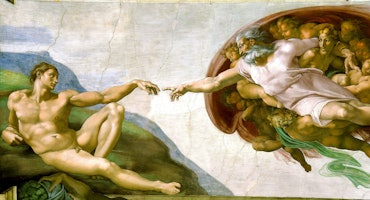
Vatican Museums & Sistine Chapel: Skip The Line
Vatican Museums & Sistine Chapel: Skip The Line
This ticket will make you save stress and time by allowing you to get priority entrance and skip the line. Visit the the countless masterpieces by Michelangelo, Raphael, Caravaggio, Tiziano and the Sistine chapel.
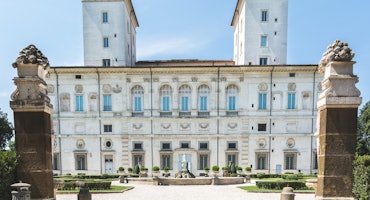
Borghese Gallery: Fast Track
Borghese Gallery: Fast Track
Galleria Borghese is located in the villa of the park Villa Borghese. Admire the architecture and furnishings of this beautiful villa. It is a museum full of art from the Renaissance. The collection includes several sculptures and paintings. Because of limited capacity get tickets for this museum weeks in advance.
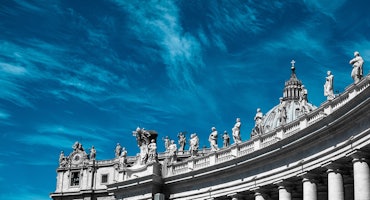
St. Peter’s Basilica: Dome Climb with Guide
St. Peter’s Basilica: Dome Climb with Guide
Get the most out of your visit to St. Peters with a guided tour to climb the basilica’s dome designed by Michelangelo and admire one of the stunning view. After the tour, you can explore the the basilica at your own pace.
The Pantheon
Let’s take a journey through the history and legends surrounding one of the most cryptic monuments of the Eternal City, to try and explain its almost magnetic appeal.
The Pantheon is still a mystery to me. No matter how much it has been studied, observed and analyzed; each time I stand in front of it, I always feel that there is something inexpressible about it, yet extremely powerful and evocative. In fact, not only is it one of the most well-preserved remains of the Roman Empire, as we will see, it is much more than that.
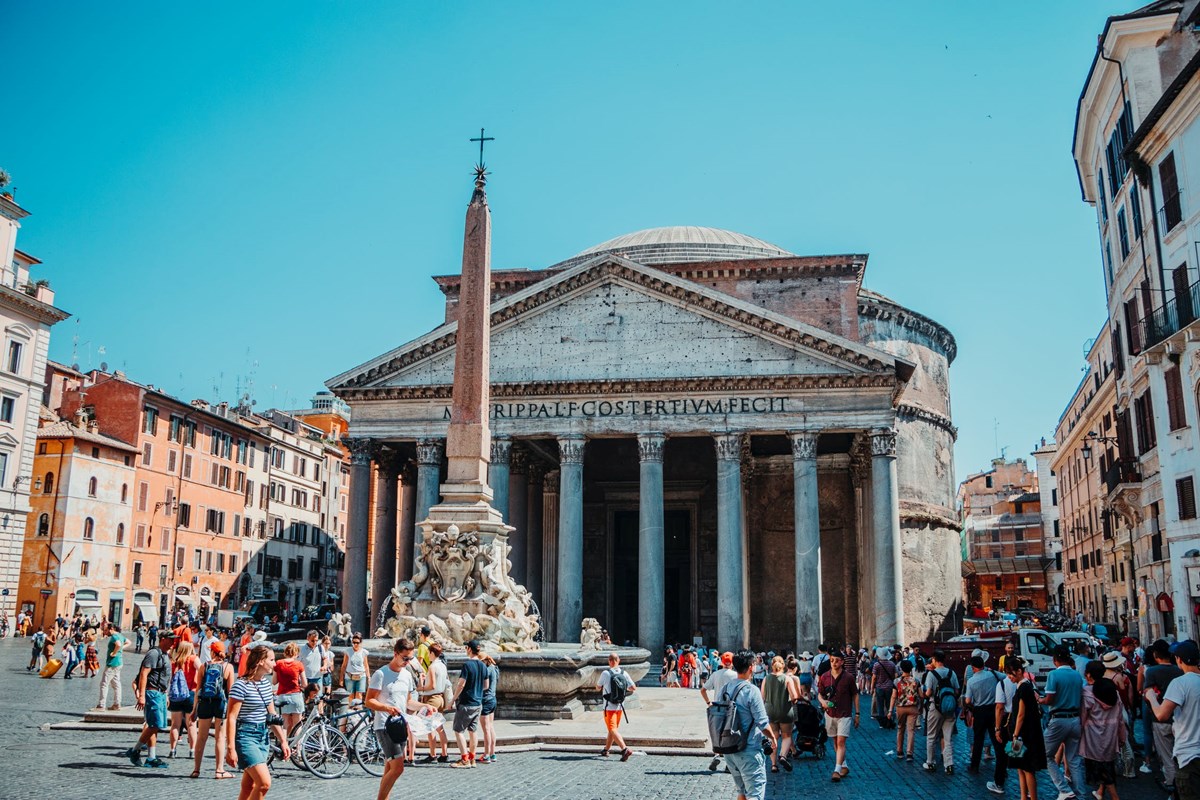
The Pantheon and its Square across the Centuries
If every city has a soul, Rome’s personality is strong, majestic, and intimate. It is beautifully conflicting. In poetry and songs, Rome is often personalized as a charming lady who fascinates and seduces you, but always keeps her distance, and, benevolent and amused, observes you as you try to capture its essence.
The square where the Pantheon is situated, lies at the junction of a bunch of narrow and intricate streets. Reluctant to bow to any sort of master plan, this city’s historical district (called Pigna) feels like a maze to me. The square where the monument stands is called Piazza della Rotonda (The Square of the Rounded Building – which of course is the Pantheon), and has a slight slope, which is demonstrated by the different number of marble steps around the base, the fountain placed in the middle of it.
Piazza della Rotonda, and its surroundings, were populated with many buildings dating as far back as the Roman Empire. I can’t help but think about the fact that Roman senators used to hold their meetings in this exact spot, while the city was at its peak of imperial splendor.
Years and centuries later, after hoards of barbarians had swept the city and Rome suffered destruction, food shortages, and humiliation, this place was still thriving with the survivors, now citizens of the Vatican State. Around 1600, a fish market was regularly held here, contrary to the will of the Pope, who wanted to give back some well-deserved dignity to this square and its main monument.
Let’s take a quantum leap. At the beginning of 1800, the square was exactly as you see it now, and, among the Romans living and working in this lively area, we find the clever Gioacchino Belli, the iconic poet who wasn’t afraid to express himself using the local dialect, elevating it to the honors of fine literature.
And now, let’s go back to the Pantheon. Before we talk about the history of the building and its features, and then dig into the magic and mystery of the legends surrounding it, there’s one thing that strikes me each time I come here. The Pantheon, more or less how I see it today, has witnessed more than 2000 years of history, with its unusual rounded shape and cleverly built dome. It was built as a temple to adore pagan gods; in some way, it indeed looks like a work of art inspired by a mighty and unknown creative force.
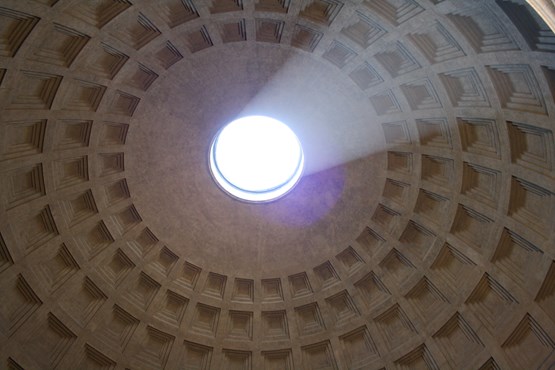
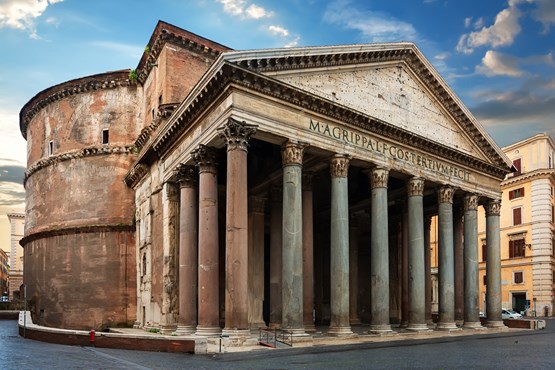
History: The Hadrian Legacy
The original Pantheon was built in 27 BC by a powerful Roman politician named Agrippa. In 110 AD, a devastating fire raged through Rome, and, among many other buildings, badly damaged the monument. Around 120 AD, the Emperor Hadrian decided to rebuild the structure, giving it its characteristic circular design, with the column pronao (the monumental porch). The Pantheon is Roman in structure, but with a Greek twist, starting with its purpose. In fact, in pure Greek style, it was dedicated to many different gods.
The Emperor and “philosopher” Hadrian was greatly influenced by the Hellenistic period of ancient Greece. The building blends the Greek-style front with the magnificence of the large dome, which is the result of the advanced construction skills of Roman architects.
Hadrian wanted to testify the greatness of the Roman Empire, but at the same time pay a tribute to what he considered the other main influential culture of the time, also on a philosophical point of view: Greece.

Hadrian worked towards the consolidation of the empire’s borders (for example the Hadrian Wall in Britain) and was an educated scholar, aesthete, musician, architect and fine arts lover. His reign was characterized by efficiency, tolerance, peace and arts' splendor. A trip to his country residence, the archaeological site of Villa Adriana (Tivoli), is like a journey in the past, and a must-see if you decide to take a trip a short distance from the city. As his funerary monument, he wanted to build a gigantic building (the Mole Adriana), which, during the centuries, has been modified and restructured. Guess how it is known now? It’s precisely the Papal fortress beside the Vatican: Castel Sant’Angelo (Saint Angel Castle.)
In 609, Pope Boniface IV transformed the Pantheon into a Christian church and consecrated it to Sancta Maria ad Martyres, now known as Santa Maria of the Martyrs. Since the Renaissance, the Pantheon has been used as a burial place for prominent Italian personalities.
The inscription made of large bronze letters on the front wall reads: Marcus Agrippa, Lucii Filius, Consul Tertium Fecit that could be translated as Marcus Agrippa, Son of Lucius, Consul Three times, Built this. The bronze letters of the inscription were originally added during Hadrian’s rebuilding.
Hadrian did not put his name on the front wall. Apparently, he took this decision to avoid offending the Senate and to celebrate the relevance of Augustus and its next of kin, Agrippa.
The dome has a height and width of 43.30 meters: it’s a perfect shape. The porch is 33 meters wide, and the walls are 6.2 meters thick, The oculus, at the top of the dome, is nine meters wide.
On the 21st of June, the summer solstice, a ray of light coming from the oculus is directed toward the exact middle of the access portal, to represent the connection between men and gods.
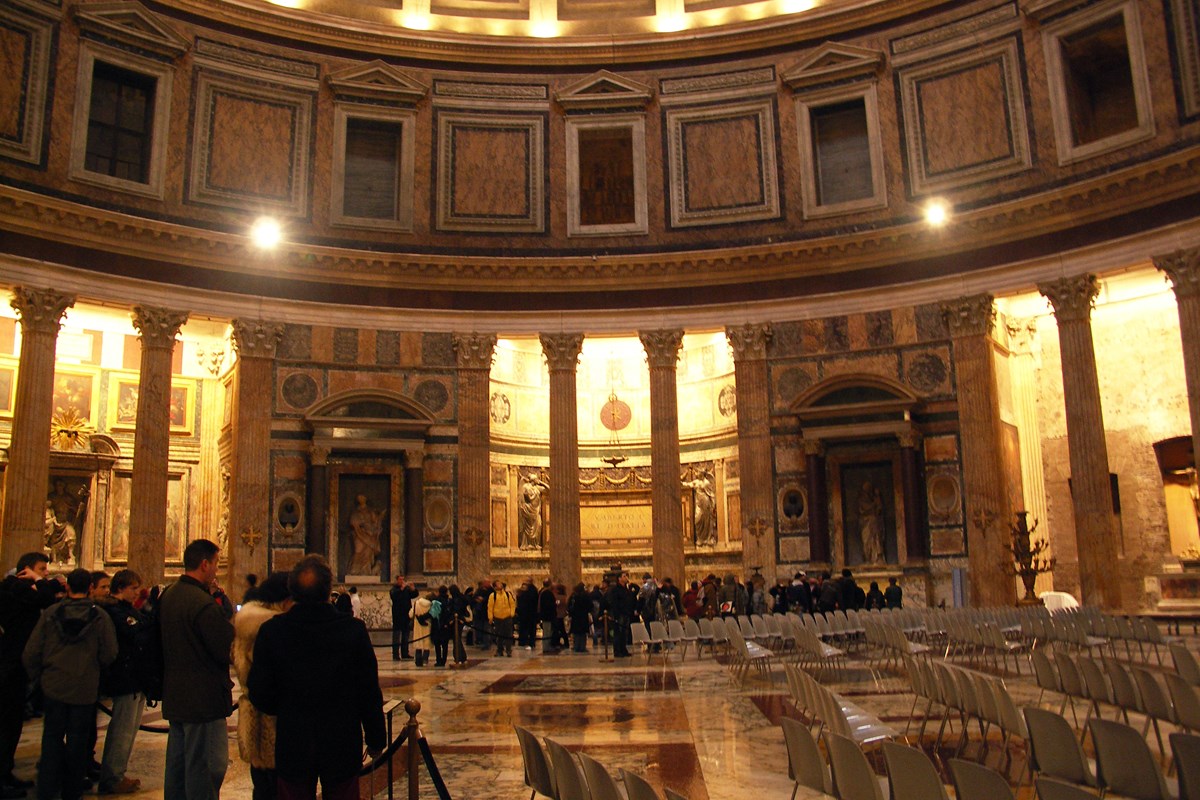
Damage, Despoliation and Restoration Works
The Pantheon has gone through many natural disasters; yet, it has always been restored. In the course of the years, however, the bronze was looted from the building and the statues were melted for the metal. The inscription on the Pantheon was removed. Just like what happened to the Triumphal Arches and the monumental structures, it was melted down to be used for the canopy over the burial of Peter, which is found in St. Peter’s Basilica, and guns for the Castel Sant’Angelo.
The letters were later replaced, and the blueprint was used as a model for the writings on churches and civil buildings. They were the foundation model for the current field of typography.
If you stand in front of the monument, you’ll notice that the last three granite columns on the left are different from the others. In fact, they have been used to replace the damaged ones, as part of the restoration works that took place in 1666. The columns come from the now almost completely destroyed huge thermal complex built by Nero in 63 AD.

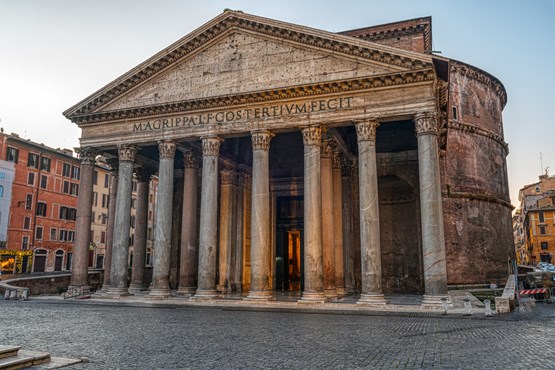
Myths and Legends
IT DOESN’T RAIN INSIDE THE PANTHEON
Despite the oculus at the center of the dome having a diameter of 9 meters, many travel guides state that, for some supernatural reason, it does not rain inside the Pantheon. Actually there’s some truth to that, and this happens due to a peculiar physical phenomenon, the so-called chimney effect. In fact, the hole creates an updraft, which helps to vaporize the drops of a light rain. But, if the rain gets heavier, I can confirm that it will come across the hole and make it to the building’s pavement! In fact, you will notice that there are some grids placed just under the oculus, to help drain the excess water.
THE LEGEND OF THE FIRST PANTHEON
Legend has it, that one of the founders of Rome (Romulus) passed away while he was reviewing the assembled Roman army. He wasn’t buried, as his body ascended to heaven. In this very spot, more or less where the Trevi Fountain is today, stood a monument called Pantheon. There is no archaeological evidence, but the story still lives on.
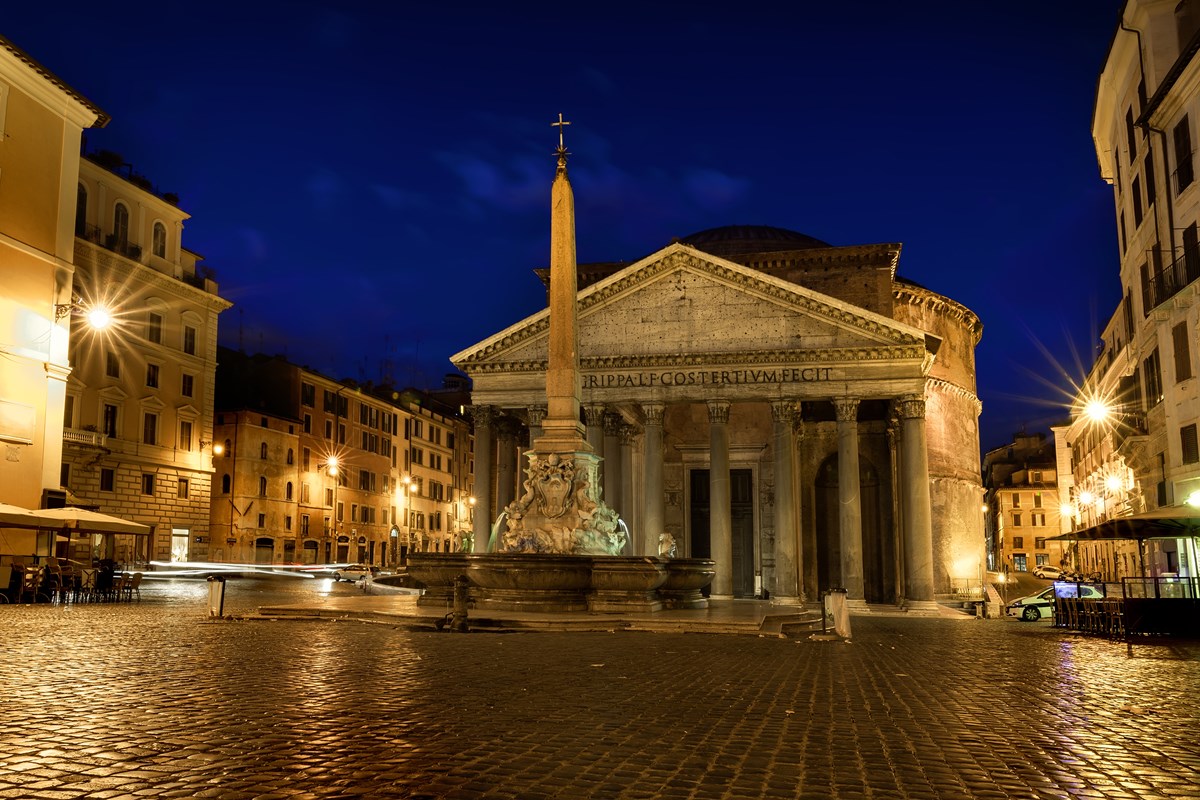
THE KING’S GHOST
The Pantheon is the burial site of the artist Raffaello Sanzio and some Italian kings. One of them, Umberto I lies here after being brutally assassinated in 1900. His ghost sometimes wanders around the monument and, on one occasion, during the thirties, approached a guard to give him a message of a political nature. For unknown reasons, the guard never wanted to reveal what is still now a secret. As confirmation of the creepy encounter, he showed a burned red streak on his uniform, caused by the touch of the ghost.
Aside from legends and popular beliefs, the Pantheon is a hymn to culture, arts and the power of men, conveyed in a temple. In Emperor Hadrian's view, it was probably the closest that men could get to attempt reaching out to deities and deserve their protection, elevating themselves through culture, ingenious balance and sacred creativity.
The feeling of belonging that I feel toward this monument and the square, goes beyond his artistic value. It’s, ultimately, a bond with our origins and with all that has led us to being the way we are now, for better or worse.
“
As Hadrian himself says, through the words of Marguerite Yourcenar in her extraordinary best seller Memories of Hadrian: “My intention was that this sanctuary of All Gods should reproduce the terrestrial globe and the stellar sphere, that globe which encloses the seeds of eternal fire, the hollow sphere containing all.”
The Grave of Vittorio Emanuele II
The Pantheon is the burial site of two Italian kings and a queen: Vittorio Emanuele II, Umberto I and Margherita of Savoy, his wife and queen.
Vittorio Emanuele belonged to the House of Savoy, a powerful family that reigned over the Kingdom of Piedmont, in north-west Italy. Both on a political and strategic level, Piedmont played an important part in the unification of Italy, which happened after a series of wars knows as the Italian Wars of Independence (1848-1866). During the conflicts, Vittorio Emanuele was crowned as King of Italy. The first Italian capital was Turin, then, after the unification was complete, the capital moved to Florence and, finally, to Rome.
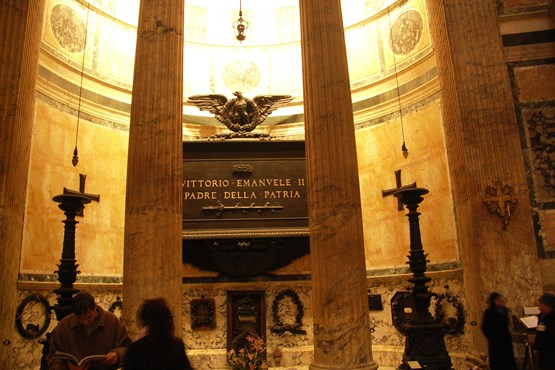
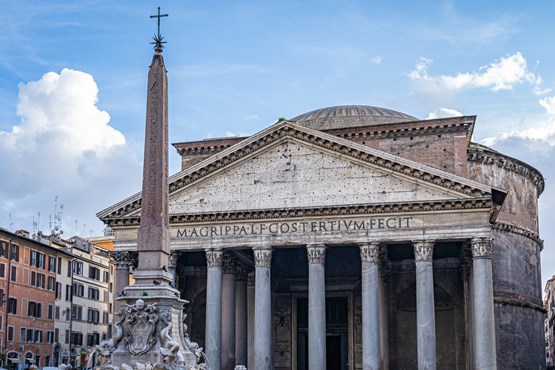
A consistent number of veterans from the Italian Wars of Independence organized themselves in a national association. When the king died, in 1878, the association decided to create a special guard corps, to honor the king and its dynasty. The members of this association, on a voluntary basis, have the duty to guard the graves of the kings. Today, the guard is still present in the Pantheon. You can recognize them by their dark cloak featuring the royal emblem. On the grave of the king, together with the symbols of the House of Savoy there is a simple inscription: Vittorio Emanuele II, Father of the Nation.
The Fountain of the Square
Simply called the Fountain of Piazza della Rotonda, this fountain is fed by the same aqueduct that provides water to the Trevi Fountain. Its wide marble steps are accessible and a perfect fresh resting spot during your walking tour. Originally built in the fifteenth century, it was completely renovated several times. The main structure you see now is a project dated 1711, and commissioned by Pope Clemens, who also decided to place an Egyptian obelisk (circa. 1200 BC) in the middle of the marble complex. The water basin is the only reminder of the original work carried out by Giacomo della Porta, a famous architect of the Renaissance, who built many monuments, buildings and fountains in Rome.
There’s a saying, in the Roman dialect, that goes: “Dimme ‘er Pantheon, e no ‘a Ritonna”, which literally means “Say Pantheon, not the Rotonda”, which is an invitation to talk straight, and call things by their own name.
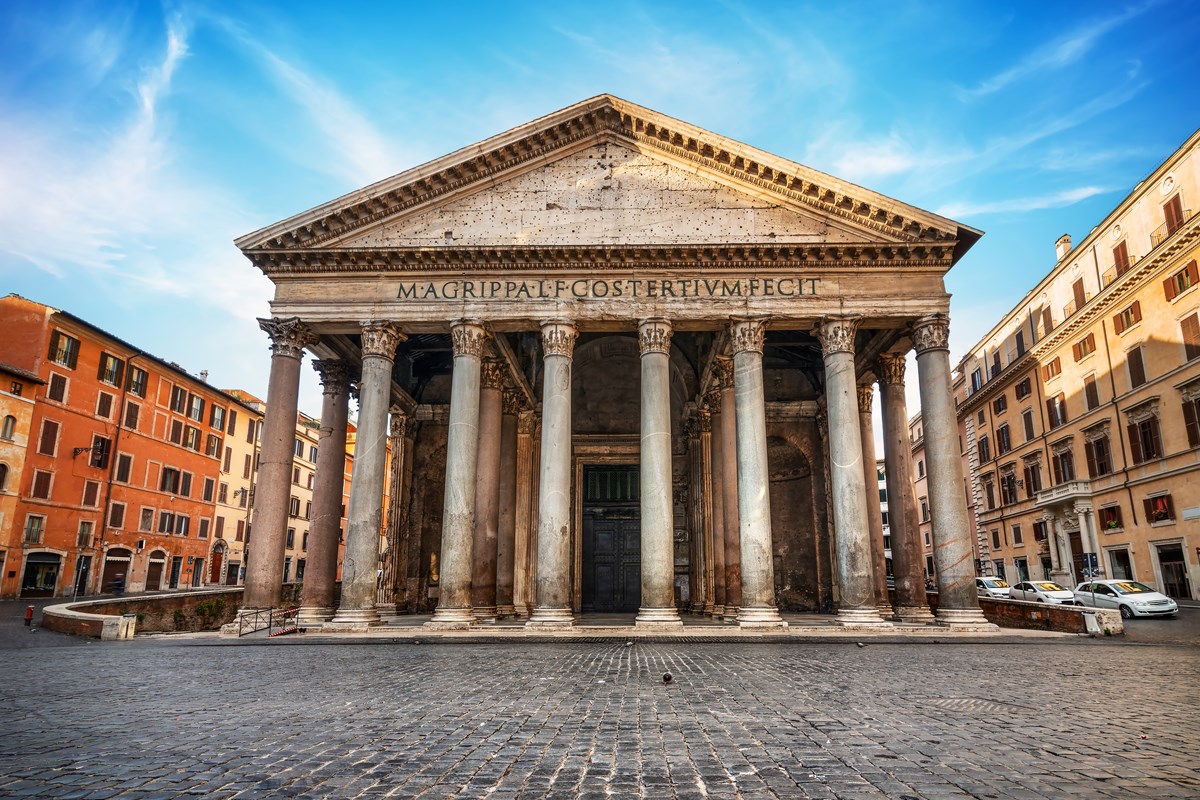
Opening Hours
The monument is open every day of the week, from 9 am to 9 pm. It’s closed on the 1st of January, 15th of August and 25th of December. Entrance is free. To avoid queues, it’s best to arrive before 10 am, especially during the peak season.
Travel Tips
Today, the Pantheon is a house of worship. As is the case for any other churches in the Capital, you should cover your shoulders when you walk in. Shorts above the knee may not be welcomed, either. Turning your phone off is also considered good practice. Visiting hours may vary according to special religious celebrations. To avoid queues at the entrance, it’s best to arrive at the Pantheon at around 10 am.
If it gets very hot, you’ll be able to refill your water bottle at the public fountain in the middle of the square.
But, in case you need more than water to keep up with your sightseeing endeavors, then, facing away from the monument, take the street called Via del Pantheon, and then the narrow Via della Maddalena. Here, at number 19 you’ll find the paradise of Italian ice-cream, the Gelateria della Palma, which offers as many as 150 different ice-cream flavors. It’s usually packed with customers, but don’t get discouraged: the service in incredibly fast! Just remember to pay at the cashier before queuing at the counter.
FAQ
Where is the Pantheon?
The Pantheon is located between Piazza Navona and the Trevi fountain. The nearest metro stop is Barberini line A. From there it is about an 8 minute walk.
Are entrance fees requested for the Pantheon?
No, access to the Pantheon is free.
Why is there a hole in the roof of the Pantheon?
The construction of the dome with a hole in it ensures that the Pantheon is protected against earthquakes. In addition, there is a beautiful light through this hole, which is actually the only original lighting source.
When was the Pantheon built?
The Pantheon was built as a pagan temple 27 BC. The building was later consecrated as a Catholic church.
What can be seen in the Pantheon?
The hole in the roof gives the Pantheon a nice light. The tomb of Victor Emanuel II, the first king of Italy, is in the Pantheon.
Is the Pantheon a church or a temple?
The Pantheon is a church, but it used to be a temple. When Christianity emerged as a faith, the Pantheon was consecrated as a church.



